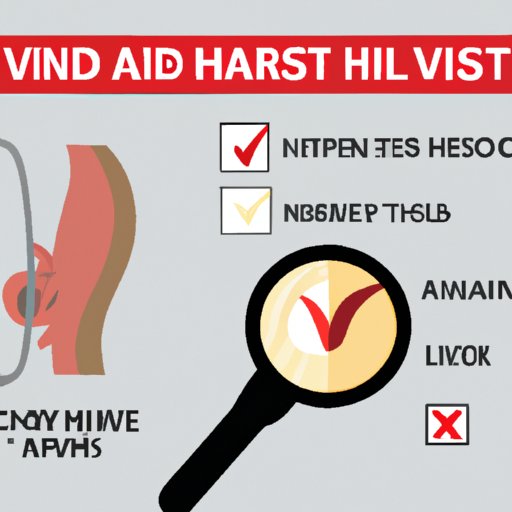
I. Introduction
HIV, the human immunodeficiency virus, is a virus that attacks the immune system, making it harder for the body to fight off infections and diseases. It can take years for an HIV infection to turn into AIDS, but that process can be slowed down with proper treatment. It’s important to understand the early warning signs and stages of HIV so that you can seek medical attention as soon as possible. In this article, we’ll explore when HIV symptoms show up, the different stages of HIV, and why it’s important to recognize HIV symptoms and seek early testing.
II. Early Warning Signs of HIV: What You Need to Know
The early warning signs of HIV can often be mistaken for the flu or another viral infection. These symptoms can occur within two weeks to a month after infection. Some common early warning signs of HIV include:
- Fever
- Headache
- Sore throat
- Fatigue
- Swollen lymph nodes
- Muscle aches and joint pain
- Nausea and vomiting
- Rash
It’s important to recognize these symptoms and seek medical help if you experience any of them, especially if you have engaged in activities that put you at higher risk for HIV infection, such as unprotected sex or sharing needles when injecting drugs.
III. Breaking Down the Timeline of HIV Symptoms
HIV progresses through several stages, each with its own set of symptoms:
- Acute HIV Infection: Within two to four weeks after infection, many people experience flu-like symptoms such as fever, headache, and sore throat. This stage is called acute HIV infection.
- Clinical Latency: After the acute stage, HIV may not cause any symptoms for several years. This stage is called clinical latency.
- AIDS: As HIV continues to damage the immune system, it may progress to AIDS, the final stage of HIV infection. This can take anywhere from two to 15 years. AIDS is characterized by severe immune deficiency and the development of opportunistic infections.
The symptoms that occur during each stage of HIV can vary widely. During the acute stage, the symptoms are similar to the flu. During the clinical latency stage, there may be no symptoms at all. And during the AIDS stage, a variety of infections and conditions can develop, such as pneumonia, tuberculosis, and Kaposi’s sarcoma.
It’s important to note that early symptoms of HIV are often ignored or attributed to other causes. This is why it’s important to know your risk factors for HIV and to get tested regularly.
IV. The Importance of Early HIV Testing and Symptom Recognition
Early testing and symptom recognition are key to managing HIV. Early diagnosis and treatment can help slow down the progression of HIV and reduce the risk of transmitting the virus to others. HIV testing is widely available and can be done anonymously and confidentially. Many people living with HIV have no symptoms at all, which is why testing is so important.
Recognizing and knowing the symptoms of HIV can also help individuals seek medical attention earlier. This can lead to earlier diagnosis and better outcomes. Early treatment can also help reduce the risk of developing opportunistic infections and other complications associated with HIV infection.
V. Understanding the Common Symptoms of HIV and How to Seek Proper Treatment
Some common symptoms of HIV include:
- Fever
- Night sweats
- Chills
- Weight loss
- Fatigue
- Swollen lymph nodes
- Diarrhea
- Nausea and vomiting
- Recurring infections
If you suspect you may have HIV, it’s important to seek proper treatment as soon as possible. Treatment typically involves antiretroviral therapy, which can help manage HIV and reduce the risk of transmission. Your healthcare provider can help determine the best course of treatment for you.
VI. From Exposure to Diagnosis: The Stages of HIV Symptoms
Here is a breakdown of the timeline of HIV symptoms:
- Exposure to HIV: HIV enters the body through bodily fluids such as blood, semen, vaginal fluids, and breastmilk.
- Acute HIV Infection: Within two to four weeks after exposure, many people experience flu-like symptoms such as fever, headache, and sore throat.
- Clinical Latency: After the acute stage, HIV may not cause any symptoms for several years. This stage is called clinical latency.
- AIDS: As HIV continues to damage the immune system, it may progress to AIDS, the final stage of HIV infection. This can take anywhere from two to 15 years.
It’s important to get tested regularly if you engage in activities that put you at risk for HIV infection. This includes having unprotected sex or sharing needles when injecting drugs.

VII. HIV Symptoms: What to Expect and When to See a Doctor
If you suspect you may have HIV, it’s important to seek medical attention as soon as possible. Your healthcare provider can help determine if you have HIV and what kind of treatment is right for you. HIV testing is widely available and can be done anonymously and confidentially.
During an HIV test, a healthcare provider may take a blood sample or use a swab to collect a sample of cells from the inside of your cheek. If the test comes back positive, it’s important to seek proper treatment and follow-up care. Your healthcare provider can help you manage your condition and reduce the risk of transmission to others.
VIII. Conclusion
Recognizing and knowing the symptoms of HIV can help individuals seek medical attention earlier, leading to earlier diagnosis and better outcomes. Regular HIV testing is key to managing HIV and reducing the risk of transmission. If you suspect you may have HIV, it’s important to seek proper treatment and follow-up care. Early diagnosis and treatment can help reduce the risk of developing opportunistic infections and other complications associated with HIV infection.




